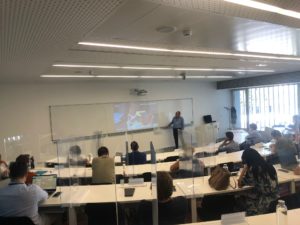
The general manager of the PAV, Francesc Sánchez, explained in EDEM the keys to consolidate Valenciaport as a strategic port in the Mediterranean.
Accessibility, logistics development, intermodality, dry ports, sustainable infrastructures and digitalisation are some of the fundamental factors to respond to international demand and the needs of its area of influence.
The students of the Operations module of the EMBA with specialisation in Marketing, Finance and Digital Business of EDEM have learnt first-hand how the Port of Valencia works.
The geographical position, the development of the hinterland, the adaptation of port spaces or the implementation of advanced services that respond to the needs of the port and logistics community are the key factors of port competitiveness. This was explained by the director general of the Port Authority of Valencia (PAV), Francesc Sánchez, in a conference with the students of the EMBA master’s degree of EDEM, where he gave an overview of the current context of maritime traffic and the role of the ports in economic activity.
“Valenciaport is making a firm commitment to strengthen its position as a strategic port in the Mediterranean at the service of the import/export fabric of its area of influence and a link in the logistics chain to continue to be competitive in a global market that is bringing together operations in hub ports”, Francesc Sánchez indicated. In this sense, he explained that the growth of international trade is producing a process of concentration of large shipping companies, the increase in the size of ships, the reconfiguration of maritime networks, the commitment to more sustainable means of transport and the use of alternative fuels to oil derivatives or the improvement of logistics infrastructures to make them more operational and environmentally friendly.
Thus, during his speech, the general manager of the PAV pointed out some of the key factors of port competitiveness on which Valenciaport is working to consolidate its leadership in the logistics chain at the service of the business fabric. For Francesc Sánchez, the geographical position of the Port of Valencia with minimum detours about the major shipping routes, the connections of the port with its nearby and remote hinterland or the complementarity of services with the integration of the port facilities with goods interchange stations or logistics activity areas are a competitive asset.
Along these lines, the PAV is also providing port land with infrastructures adapted to maritime transport trends and is developing initiatives to absorb the long-term growth of international trade. Another area of work is the implementation of advanced services for the port and logistics community (digital transformation, quality, integration of information, labour flexibility, etc.) to facilitate the operation of import/export companies.
These actions are integrated into the main challenge for international trade: sustainability. Therefore, all these projects are under the umbrella of the Valenciaport 2030 objective, zero emissions, which will place the PAV’s managed facilities as a benchmark in making growth compatible with the fight against climate change.
Hinterland strategy
The director general of the PAV also stressed the need to increase the size and operability of the port areas to meet the demands of an increasingly competitive global market. Thus, Valenciaport is committed to the development of its area of influence with commercial policies aimed at increasing the volume of cargo in the immediate hinterland and the extension to more distant areas by means of intermodal communication infrastructures.
To this end, the PAV is working on accessibility, logistics development, intermodality, the creation of dry ports, the implementation of marketing strategies that favour the work of the port community, the promotion of Valenciaport, transparency in information and the implementation of mechanisms that respond to the needs and requirements of the companies that operate in Valenciaport.
In this sense, the PAV is making progress with specific projects such as the new north container terminal that combines sustainability and digitalisation or the development of the railway in the port facilities and in the connection with its surroundings. In this rail-maritime transport intermodality, it is supporting the improvement of the Valencia-Teruel-Zaragoza line or acting to promote the Madrid Centro corridor (Valencia-Madrid-Lisbon/Sines), the Mediterranean Corridor or the Cantabrian-Mediterranean Corridor (Valencia-Sagunto-Teruel-Zaragoza-Bilbao/Santander).
Visit to the facilities
After the presentation of the general director of the PAV, the students of the EMBA specialisation in Marketing, Finance or Digital Business of EDEM, toured the facilities of the Port of Valencia where they learned first-hand about the daily operation of the port activity and the projects that Valenciaport is carrying out to improve its service to the business fabric of its area of influence.

